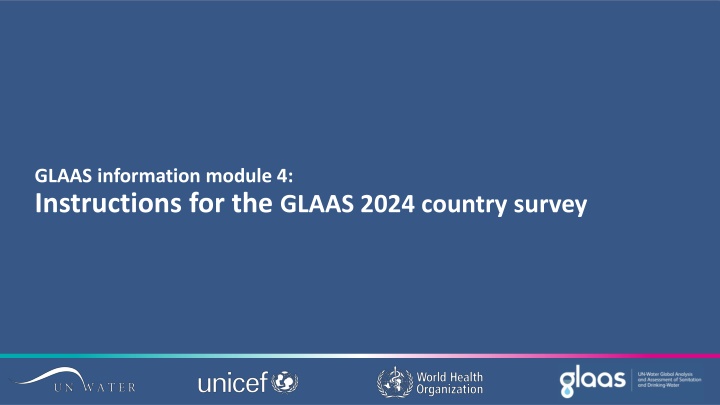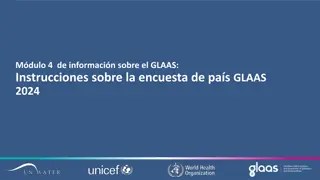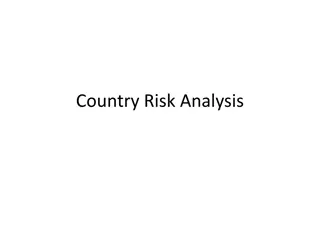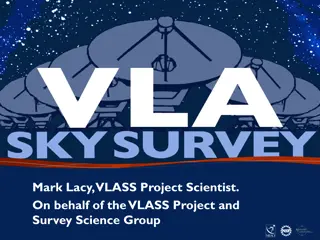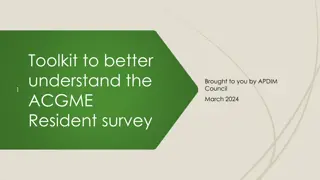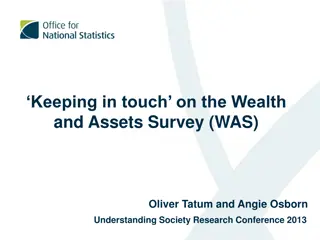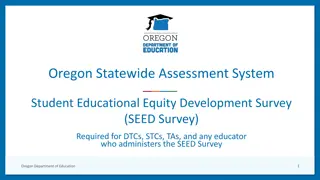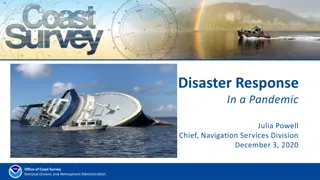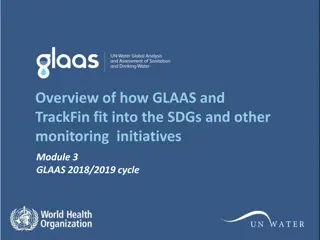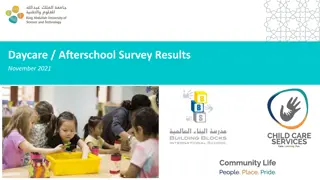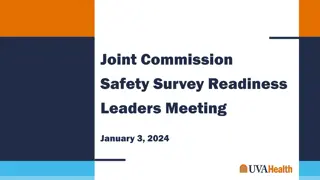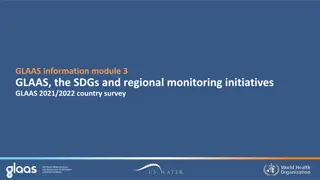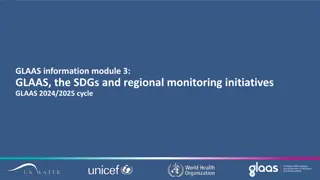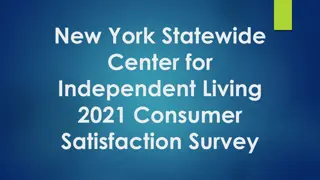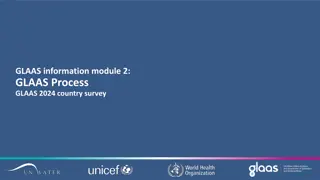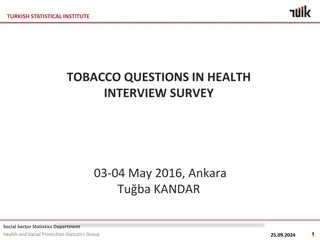Guidelines for GLAAS 2024 Country Survey
GLAAS 2024 Country Survey instructions include completing the survey either as a PDF or online using eGLAAS. Tips for success in governance, monitoring, human resources, and financing are provided. Deadline for submission is October 15, 2024. The survey package includes various forms and additional document attachments. User feedback on piloting eGLAAS in previous cycles highlights its user-friendliness and efficiency in data collection.
Download Presentation

Please find below an Image/Link to download the presentation.
The content on the website is provided AS IS for your information and personal use only. It may not be sold, licensed, or shared on other websites without obtaining consent from the author.If you encounter any issues during the download, it is possible that the publisher has removed the file from their server.
You are allowed to download the files provided on this website for personal or commercial use, subject to the condition that they are used lawfully. All files are the property of their respective owners.
The content on the website is provided AS IS for your information and personal use only. It may not be sold, licensed, or shared on other websites without obtaining consent from the author.
E N D
Presentation Transcript
GLAAS information module 4: Instructions for the GLAAS 2024 country survey
Information module 4 includes Overview of the survey package Choosing how to complete the country survey: PDF or online (eGLAAS) General instructions for the GLAAS 2024 country survey Tips for success in Section A: Governance Tips for success in Section B: Monitoring Tips for success in Section C: Human resources Tips for success in Section D: Financing
The GLAAS survey package Deadline for submission: 15 October 2024 Each country should submit one each of the following: GLAAS 2024 country survey Country feedback form Consent form (if applicable) Attach additional documents, as requested throughout the survey (e.g. national policies) Use the Country survey guidance for instructions and definitions. From April 1st2024, materials are available here: https://glaas.who.int/ If you have any questions, please contact glaas@who.int.
Choosing how to complete the country survey: PDF or online (eGLAAS)
Choosing how to complete the country survey The GLAAS 2024 country survey is available either as: 1) a fillable PDF form; or 2) an online survey called eGLAAS. eGLAAS is developed using REDCap and hosted on WHO s instance of the platform called Electronic Data Capture REDCap (EDCRC). The focal point, with stakeholders, should decide how best to coordinate the GLAAS process and determine which form (PDF or eGLAAS) will be best for the country.
User feedback on Pilot of eGLAAS In the GLAAS 2021/2022 cycle, 11 countries successfully piloted eGLAAS to complete the country survey. Both experienced and first-time GLAAS contributors found the online survey to be user-friendly. Teams found it especially useful that multiple survey contributors could access the platform and contribute responses to survey questions, which saved time and made the process more efficient. The process of checking errors and communicating them through eGLAAS platform was excellent. It allowed the reviewers time to consult the country team virtually until a consensus was reached. In general, eGLAAS is user- friendly and facilitates the data collection process.
Main differences between fillable PDF and eGLAAS PDF eGLAAS Software and access requirements Contributors must have an updated version of Adobe Acrobat Reader installed on their computers. Internet access is not required to complete the survey. Survey contributors must have access to a web browser with internet and be registered by the WHO GLAAS team (glaas@who.int). If country survey is regularly saved, internet cuts should not be an issue. At least seven languages: Arabic, Chinese, English, French, Portuguese, Russian and Spanish. Three languages: English, French and Spanish. Available languages Multiple contributors can separately complete their own surveys on saved PDFs and the GLAAS focal point must reconcile and compile all responses into one final PDF for submission Multiple contributors can access and complete different questions simultaneously in the country survey on eGLAAS. Responses do not need to be compiled if multiple contributors are given access. Contributors can leave comments for each other in case of conflicting information in a response. Multiple user access and compiling responses See the survey guidance for more information on the differences between the fillable PDF and eGLAAS.
Accessing and using the PDF Use an updated version of Adobe Acrobat Reader DC: A free version can be downloaded in English at: https://get.adobe.com/reader/. Complete the survey on a desktop version of Adobe Reader - not a web browser version. Writing in a text response box on the PDF may not be visible on your computer screen or when printed. Use the arrows on the keyboard to scroll through text entered. Save the PDF at regular intervals. If it is not saved, responses will be lost. If multiple respondents in the country provide information in several GLAAS survey forms, the GLAAS focal point is responsible for compiling and reconciling all responses into one final country submissionin a single PDF survey form before sending to the GLAAS team at WHO.
Accessing and using eGLAAS (online) Survey contributors must be registered to the eGLAAS platform to have access to the online survey. To register contributors, the focal point must immediately contact the WHO regional office and glaas@who.int with a list of names and email addresses. To learn how to use the online platform and complete the eGLAAS survey, review the information on eGLAAS found here and/or contact the WHO GLAAS team (glaas@who.int) for further information.
General instructions for the GLAAS 2024 country survey
General instructions for the GLAAS 2024 country survey For each question, choose the response that best fits your country. Most questions require checkbox responses. Some questions allow only one response, while others allow more than one. Read the instructions carefully. Elaborate on responses in open text boxes including specific scenarios, examples, achievements and/or obstacles to progress. Some response fields have restrictions on what can be entered in the cell. For example, when asked for a percentage, only numbers between 0 and 100 are allowed without a percent sign. Pay close attention to specific instructions throughout the survey, such as pleasespecify , ifyes , and select all that apply .
Response requirements for country survey responses When starting sentences or lists, do not use punctuation such as slashes (/), hyphens (-), bullets ( ) or dashes ( ). For lists, put each item on a new line without punctuation. Ranges of years should be written as YYYY to YYYY. Do not use hyphens between the years. Correct: YEAR: 2018 RANGE: 2018 to 2021 Incorrect: YEAR: 18 RANGE: 2018-2021 Please avoid using acronyms. Instead spell out the full name or phrase. For monetary values, indicate the currency using the three letter ISO currency code. The currency codes can be found at: https://treasury.un.org/operationalrates/OperationalRates.php For some questions, if No is marked as the answer to the first part of the question, response fields for questions that are not applicable will be blocked and do not need to be answered. When prompted, please include the links to documents referenced in the survey and/or attach soft copies (PDF) or upload (eGLAAS) the documents to your submission.
General tips For some questions, your answers might be the same as previous questions. Do not use same as above , please copy and paste the answer for the question. For example, question A5 on Policies and Plans asks for policies and plans by subsector (e.g. Urban and Rural Sanitation). If you have the same policy for both urban and rural, report the same policy in both the urban and rural response fields. If a question asks for a policy, plan or regulation, please only list the most relevant document. We understand that countries often have multiple policies/plans, but the survey is designed to collect data on only one per question.
Some questions across the survey are linked or related Equity (A9, B7, D4): In your responses, make sure to identify the same populations and settings across all three questions (i.e. if the box does not exist in the country is marked for one of the questions it should be marked for all of them). A9: Equity measures in national policies and plans B7: Monitoring equity measures D4: Financing equity measures Institutional roles and budgets (A10, D2): In your responses, make sure to list the same ministries or national institutions involved in WASH in both A10 and D2. A10: Institutional roles and lead agencies D2: Government budgets for WASH To avoid conflicts, review the survey guidance instructions and your responses to these questions before submitting the survey.
Final tips for filling out the survey If you have trouble entering information in a response cell: double check the instructions in the country survey or check for the survey guidance to make sure you are entering the information required for the question. If you have any questions, please contact glaas@who.int.
Tips for success Section A Governance in the GLAAS 2024 country survey
See the survey guidance document for more instructions and definitions Questions in Section A Questions covered in this module *New question in the 2024 country survey A1: Human rights to water and sanitation A2: National regulations and standards A3: Risk management approaches A4*: Risk assessments for climate resilient WASH A5: National WASH policies and plans A6: Content of WASH policies and plans A7*: WASH in other sector policies A8: National WASH targets A9: Equity measures in national policies and plans A10-A11*: Institutional roles and coordination A12: Coordination among stakeholders A13: Community and user participation
A1 A2 A3 A4 A5 A6 A7 A8 A8 A9 A10 A11 A12 A13 A8: National WASH targets A8 asks you to report national WASH targets and/or targets for urban and rural WASH. National targets are those that cover the entire country/territory and do not distinguish between urban or rural settings. The urban and rural targets can be used to report specific targets for urban and/or rural settings. Report population or household-based WASH service targets. Each target should only be reported once. Do not report the same target more than once. Report any national, urban and/or rural targets and progress towards them for: Sanitation (A8I) Drinking-water (A8II) Hand hygiene (A8III) WASH in schools (A8IV.a) WASH in health care facilities (A8IV.b) Other targets (A8V) Any targets that have not been reported in A8I A8IV can be reported in question A8V Other targets. For each reported target, carefully detail and describe the types of facilities/services/sources or other qualities that are acceptable for an area, population or household to be considered covered under the target criteria and definition.
A1 A2 A3 A4 A5 A6 A7 A8 A8 A9 A10 A11 A12 A13 A8: National WASH targets Defining WASH targets Many countries have established national targets using SDG criteria. A8 asks: Which service level does the coverage targets most closely align with? Before answering question A8, review the service ladder definitions from the WHO/UNICEF Joint Monitoring Programme. Definitions can be found in https://washdata.org/monitoring the survey guidance document or
A1 A2 A3 A4 A5 A6 A7 A8 A8 A9 A10 A11 A12 A13 A8: National WASH targets Report baseline and latest year/value The targets questions ask for the baseline and most recent (latest) coverage data for the target described to assess progress towards national/urban/rural targets. Baseline value / Baseline year: The baseline value should measure progress towards the reported target. The baseline year should be a measurement taken in the past (e.g. 2015) but within the policy period of the target. Usually a baseline value is established in the document (national policy/plan/strategy) in which the target was defined. For example, in a National WASH Plan 2020-2025, one would expect national targets to be set with baseline values for each target specified for the year 2020 or 2019. Latest value / Latest year: Report the most recent monitored measurement for the target described. The latest value should measure progress towards the reported target. The latest year should be a measurement taken in the recent past (e.g. 2022). Example of reporting baseline and latestvalue/year: If your target aims for 100% of total population with access to safely managed sanitation by 2030, the baseline value and baseline year should correspond to the first time the total population with access to safely managed sanitation was measured (e.g., 42% in 2015). The latest value and latest year correspond to the most recent measurement of the total population with access to safely managed sanitation (e.g., 75% in 2022). Both baseline and latest year are in the past.
A13 A13 A1 A2 A3 A4 A5 A6 A7 A8 A9 A10 A11 A12 A13: Community and user participation This question is used for monitoring SDG Target 6.b on local community participation. Target 6.b aims to: Support and strengthen the participation of local communities in improving water and sanitation management
A13 A13 A1 A2 A3 A4 A5 A6 A7 A8 A9 A10 A11 A12 A13: Community and user participation For each WASH subsector, A13 asks if participation procedures are defined in law or policy. Even if your country does not define participation procedures in law or policy, report levels of participation for users/communities and women. Carefully read the definitions for the levels of participation in the question and note the distinctions to adequately classify the levels of participation for each sector. Low (2), medium-low (3) and medium high (4) levels of participation require only one- way communication without dialogue or accountability. High (5) and very high (6) levels of participation require some form of collaboration, dialogue and accountability between communities / users and government / service providers.
Tips for success Section B Monitoring in the GLAAS 2024 country survey
See the survey guidance document for more instructions and definitions Questions in Section B Questions covered in this module *New question in the 2024 country survey B1: WASH joint sector reviews B2*: National monitoring indicators for WASH plans / strategies B3: Indicator data B4*: Indicators for monitoring climate resilient WASH B5*: National management information systems (MISs) B6: Use of monitoring data B7: Monitoring equity measures B8: Regulation of drinking-water B9: Regulation of sanitation / wastewater B10: Independent drinking-water quality surveillance B11: Independent wastewater and sludge treatment surveillance
B1 B2 B2 B3 B4 B5 B6 B7 B8 B9 B10 B11 B2: National monitoring indicators for WASH plans/strategies National strategies and plans for WASH will often include a set of indicators that will be monitored to assess progress of the strategy/plan. B2 asks for information about these indicators. The question asks if your country has indicators along the results chain for the WASH system, as shown below. A results chain is way to show the steps and connections between the steps to achieve a desired result, from the resources needed and the actions taken to achieve the result to its immediate and longer-term effects. Inputs Process/Actvity Outputs Outcomes Impact This question will contribute to the work on identifying a core set of indicators to monitor the strength of WASH systems.
B1 B2 B2 B3 B4 B5 B6 B7 B8 B9 B10 B11 B2: National monitoring indicators for WASH plans/strategies Definition Example indicator WASH expenditure per capita Number of WASH trainees per year Existence of a country compact for WASH Financial, human, and other resources mobilized to support activities undertaken to achieve results Inputs % of required water quality testing conducted % of community participation meetings with service providers conducted Process/ activity Action taken or work performed by which inputs are converted into specific outputs Losses in m3/network km per day of non-revenue water % of wastewater treated Events, products, capital goods or services that result from an intervention (e.g. process/activity) Outputs Uptake, adoption or use of outputs by beneficiaries % of households with access to basic sanitation Outcomes Number of diarrheal deaths per hundred thousand people Proportion of bodies of water with good ambient water quality Impact Higher level long-term goals
B1 B2 B3 B4 B4 B5 B6 B7 B8 B9 B10 B11 B4: Indicators for monitoring climate resilient WASH This question will be used to inform the GLAAS and JMP initiative to define indicators for global monitoring of climate resilient WASH. For each subsector, indicate if indicators exist and list up to three indicators. Examples of indicators for monitoring climate resilient WASH include : Percentage of water supply technologies screened according to their suitability to withstand climate-related shocks and stresses Percentage of latrines that are immediately reconstructed following heavy rains and/or flooding Percentage of population with access to soap and water at a handwashing facility during a drought period or following a flood Please also indicate if climate resilient WASH is defined in your country and provide the definition.
B1 B2 B3 B4 B5 B5 B6 B7 B8 B9 B10 B11 B5: National management information systems A management information system (MIS) refers to a computer-based or digital system that is updated regularly and forms the basis for management decision-making. This information system should allow relevant stakeholders to report data into the system as per requirements. Countries may have more than one MIS for different purposes. B5 refers to management information systems that hold key WASH data. If your country does not have any MIS with key WASH data, please skip to question B6. Write the name of up to three MISs with key WASH data. If your country has more than one MIS, please list the MISs in order of relevance to the WASH sector. For example, if your country has a designated WASH MIS, this MIS should be listed first, followed by any relevant MISs with key WASH data, such as a health MIS. In the second column, include which entity/organization/institution manages the MIS. The remaining part of the question asks for details about the MIS(s) listed.
Tips for success Section C Human resources in the GLAAS 2024 country survey
See the survey guidance document for more instructions and definitions Questions in Section C Questions covered in this module *New question in the 2024 country survey C1: National plans/strategies for WASH human resources C2: Human resources needs assessments C3: WASH training institutions C4: Human resources constraints C5*: Attracting people to the WASH workforce C6*: Women in the WASH workforce C7: Sufficiency of human resources for WASH C8: Sufficiency of human resources for environmental health C9: Rights and safety measures for workers
C1 C2 C3 C4 C5 C6 C7 C8 C8 C9 C8: Sufficiency of human resources for environmental health The health sector has a role to play in WASH, in particular core environmental health functions. This question is focused on human resources in the health sector. Consult with colleagues from the health sector. For more information on environmental health authorities and their role in WASH, please see section 4.6 of the WHO Guidelines on Sanitation and Health.
C1 C2 C3 C4 C5 C6 C7 C8 C9 C9 C9: Rights and safety measures for workers This question focuses on the rights and safety measures for people working in drinking-water and sanitation. This question is also related to SDG 8, which is promote sustained, inclusive and sustainable economic growth, full and productive employment and decent work for all. More information about sanitation workers can be found at: https://www.who.int/teams/environment-climate-change-and-health/water- sanitation-and-health/sanitation-safety/sanitation-workers
Tips for success Section D Financing in the GLAAS 2024 country survey
See the survey guidance document for more instructions and definitions Questions in Section D Questions covered in this module *New question in the 2024 country survey D1: Financial plans D2: Budgets for WASH D3: Cost recovery D4: Financing for equity measures D5: Affordability D6 D7: Utilization of available funds (absorption) D8*: Climate finance for WASH D9: External financing D10: Sufficiency of funding D11: Financial flows
D1 D2 D2 D3 D4 D5 D6 D7 D8 D9 D10 D11 D2: Budgets for WASH In D2 ministry WASH budgets for water, sanitation and hand hygiene are requested in a disaggregated format. List all ministries involved with WASH even if specific budgets are unknown. The ministries/national institutions should be the same as those listed in A10. Budget data can be reported in any currency, but please use only one currency in answering the question. If the WASH budget cannot be disaggregated, please list the total budget. If able to disaggregate by type of cost (% Capital, % O&M/recurrent, % Other) , the totals should add up to 100% for each row.
D1 D2 D3 D4 D5 D6 D7 D8 D8 D9 D10 D11 D8: Climate finance for WASH D8 is a new question in the GLAAS country survey on climate finance. Climate finance refers to local, national or transnational financing drawn from public, private and alternative sources of financing that seeks to support mitigation and adaptation actions that will address climate change. In the first part of the question, indicate if your government has applied for climate finance for WASH from an external source such as Green Climate Fund or the Adaptation Fund. If so, indicate if the application was successful and details about funds received. Part d of the question refers to domestic resources for climate mitigation and adaptation actions that will address climate change.
D1 D2 D3 D4 D5 D6 D7 D8 D9 D9 D10 D11 D9: External funding D9 is used for SDG Target 6.a on international water cooperation. Responses are complemented by OECD Data on Official Development Assistance through Creditor Reporting System from DAC data. To answer this question, see detailed OECD-CRS codes in the survey guidance document. The question also asks countries to estimate the percentage of total donor expenditure/disbursement that is on-budget On-budget is funding provided for specific expenditures or lines in national budget, including both funding channelled and not channelled through the treasury.
D1 D2 D3 D4 D5 D6 D7 D8 D9 D10 D11 D11 D11: Financial flows for WASH D11 requests annual WASH expenditure data for the WASH sector nationally. Data are requested by funding type/revenue source (e.g., households, government, donors); and by service type (e.g. drinking-water, sanitation, hygiene). Report expenditures for the most recent fiscal year. Expenditure data in this question can be reported in any currency, but please use only one currency in answering the question. For each funding type, please mention the source(s) of information and indicate where data gaps exist. Detailed instructions for this question can be found in the survey guidance document.
Using WASH accounts to improve answers to D11 It is acknowledged that the data requested in D11 may not be readily available. To improve information on WASH financial flows, GLAAS has developed the TrackFin methodology, which results in WASH accounts, to improve information on financial flows and expenditures in WASH. For countries that have developed WASH accounts recently, the D11 table can be extracted from module 6.4 of the WASH accounts production tool.
More information on WASH accounts If your government is interested in developing WASH accounts using the TrackFin methodology, please contact: glaas@who.int For more information on WASH accounts, please see: https://www.who.int/teams/environment-climate-change-and- health/water-sanitation-and-health/monitoring-and-evidence/wash- systems-monitoring/un-water-global-analysis-and-assessment-of- sanitation-and-drinking-water/wash-accounts
Thank you! For additional information please contact glaas@who.int
